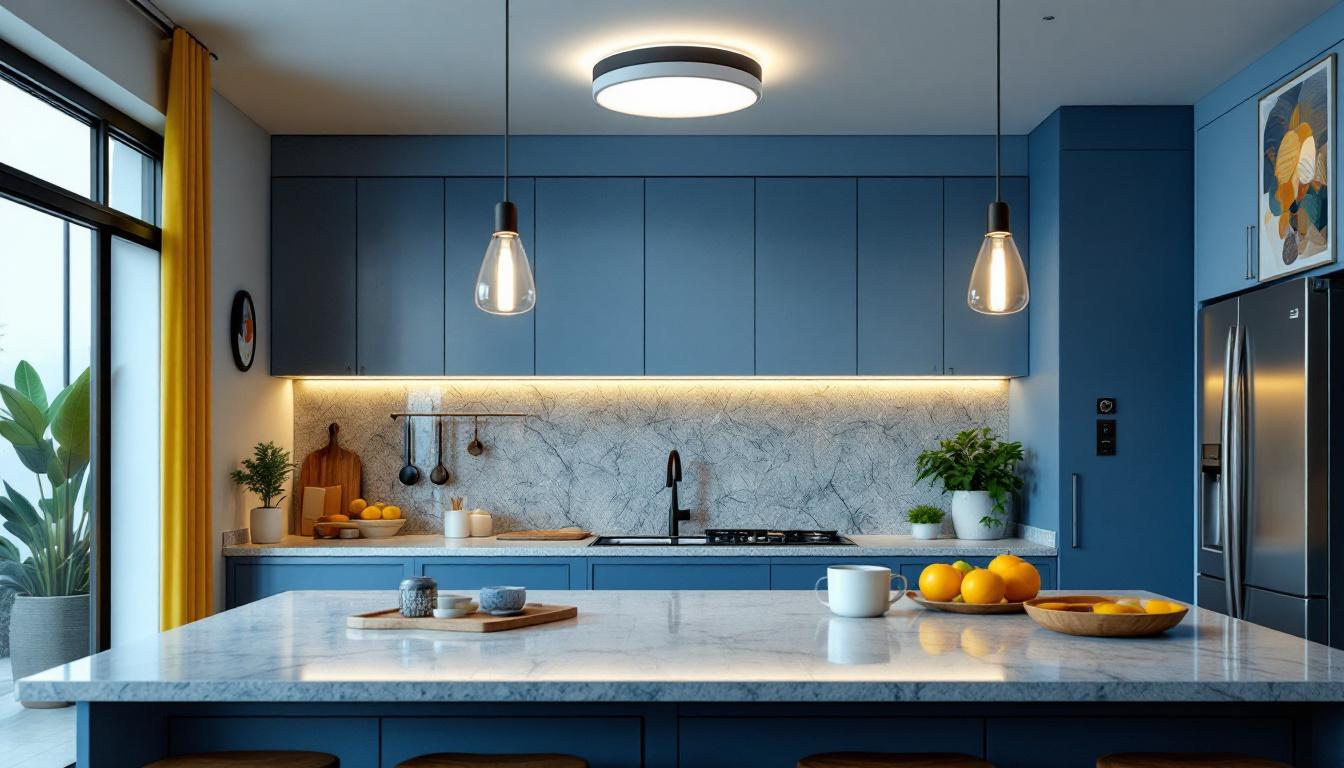
Flush mount ceiling lights are a popular choice for kitchens due to their sleek design and functionality. These fixtures sit close to the ceiling, making them ideal for spaces with low ceilings or for achieving a minimalist aesthetic. They provide ample illumination while maintaining a clean look, which is essential in a room where both cooking and socializing take place. The unobtrusive nature of flush mounts allows them to blend seamlessly with the kitchen decor, ensuring that the focus remains on the culinary creations and the interactions that happen within the space.
When selecting flush mount lights for a kitchen, it’s crucial to consider the size, style, and brightness. A well-chosen fixture can enhance the overall ambiance of the kitchen, making it a warm and inviting space. However, poor choices can lead to insufficient lighting or a cluttered appearance, detracting from the kitchen’s design. It’s also worth noting that the color temperature of the bulbs used in flush mounts can significantly affect the mood of the kitchen; warmer tones can create a cozy feel, while cooler tones can make the space feel more energetic and vibrant.
There are several types of flush mount ceiling lights available, each offering unique benefits. Traditional flush mounts often feature a simple design with a glass shade, providing a classic look that suits various kitchen styles. Modern flush mounts may incorporate innovative materials and designs, offering a contemporary twist that can serve as a focal point in the kitchen. For instance, some modern designs utilize metals like brushed nickel or matte black finishes, which can add a touch of sophistication to the overall decor.
Another option is the semi-flush mount light, which hangs slightly lower than a standard flush mount. This style can create a more dramatic effect and is particularly effective in larger kitchens where a bit more presence is desired. These fixtures often come with decorative elements such as intricate patterns or unique shapes, allowing homeowners to express their personal style. Understanding the nuances between these types can help in making informed decisions that enhance the kitchen’s overall aesthetic, ensuring that the lighting complements not just the functionality but also the character of the space.
When planning kitchen lighting, it is essential to consider both functional and aesthetic factors. The kitchen is a multi-purpose space, and the lighting should accommodate various activities, from meal preparation to entertaining guests. Bright, focused lighting is necessary for tasks such as chopping vegetables or reading recipes, while softer lighting can create a cozy atmosphere for dining. Layering different types of lighting, including task, ambient, and accent lighting, can help achieve a well-rounded illumination scheme that meets all these needs.
Additionally, the layout of the kitchen plays a significant role in determining the best lighting solutions. An open-plan kitchen may require different lighting strategies compared to a more enclosed space. For instance, in an open kitchen, flush mounts can help to unify the space, while pendant lights over an island can provide targeted illumination. Understanding the specific needs of the kitchen will help in selecting the most appropriate flush mount lighting solutions, ensuring that every corner of the kitchen is both functional and aesthetically pleasing. Moreover, considering energy-efficient options, such as LED flush mounts, can contribute to long-term savings and sustainability, making your kitchen not only beautiful but also eco-friendly.
Lighting projects can be complex, and mistakes can lead to costly consequences. Avoiding common pitfalls is essential for achieving a successful outcome. Here are some key mistakes to watch out for when planning your flush mount ceiling light installation in the kitchen.
One of the most frequent mistakes is underestimating the brightness required in the kitchen. Kitchens typically require more light than other areas of the home due to the nature of the tasks performed there. A common guideline is to aim for around 100-150 lumens per square foot. However, this can vary based on the kitchen’s specific layout and the activities that will take place.
To avoid this mistake, consider incorporating multiple light sources, including task lighting and ambient lighting. Flush mount lights can provide general illumination, but additional fixtures may be necessary to ensure that all areas of the kitchen are adequately lit.
The color temperature of light bulbs can significantly impact the kitchen’s atmosphere. A common oversight is not considering how the light will interact with the kitchen’s colors and materials. Warmer temperatures (around 2700K to 3000K) create a cozy, inviting environment, while cooler temperatures (above 4000K) can feel harsh and sterile.
Choosing the right color temperature is crucial for enhancing the kitchen’s design. For example, if the kitchen features warm wood tones, a cooler light may clash with the overall aesthetic. It is advisable to test different bulbs in the space to see how they affect the kitchen’s ambiance before making a final decision.
Another common mistake is overlooking the benefits of dimming capabilities. Dimmers allow for greater control over the lighting, enabling adjustments based on the time of day or the specific activity taking place. For instance, bright lighting may be necessary during meal preparation, while softer lighting can create a more relaxed atmosphere during dinner parties.
Incorporating dimmers into the lighting design can enhance the kitchen’s versatility. It is essential to ensure that the chosen flush mount fixtures are compatible with dimmer switches to avoid any issues during installation.
A well-designed lighting plan is essential for creating a harmonious kitchen environment. This involves not only selecting the right flush mount ceiling lights but also considering how they fit into the overall design scheme. Here are some tips for designing a cohesive lighting plan.
Layering different types of lighting is key to achieving a balanced and functional kitchen. This includes ambient lighting, task lighting, and accent lighting. Flush mount ceiling lights can serve as the primary ambient light source, but it is important to complement them with task lighting, such as under-cabinet lights or pendant fixtures over an island.
Accent lighting can also play a significant role in highlighting architectural features or decorative elements in the kitchen. By combining various light sources, the kitchen can achieve a well-rounded illumination that enhances both functionality and aesthetics.
The placement of flush mount ceiling lights is another critical aspect of the lighting design. Proper positioning can help eliminate shadows and ensure that all areas of the kitchen are well-lit. It is advisable to place fixtures evenly throughout the space, particularly in areas where tasks will be performed.
For larger kitchens, consider using multiple flush mount fixtures or supplementing them with additional lighting options to ensure even coverage. The goal is to create a seamless flow of light that enhances the kitchen’s usability and visual appeal.
The style of the flush mount ceiling light should complement the overall design of the kitchen. Whether the kitchen has a modern, traditional, or eclectic style, the chosen fixtures should align with that aesthetic. This includes considering the materials, colors, and shapes of the lights.
For instance, a sleek, metallic flush mount may suit a contemporary kitchen, while a vintage-inspired fixture may be more appropriate for a farmhouse-style space. Selecting fixtures that harmonize with the kitchen’s design can elevate the space and create a cohesive look.
Proper installation is crucial for ensuring that flush mount ceiling lights function effectively and safely. Here are some essential tips for successful installation.
Before installation, it is important to assess the electrical needs of the flush mount ceiling lights. This includes checking the existing wiring and ensuring that it can support the new fixtures. If there are any concerns about the electrical system, it is advisable to consult with a licensed electrician to avoid potential hazards.
Additionally, consider the wattage of the bulbs being used. Exceeding the recommended wattage can lead to overheating and pose a fire risk. Always adhere to the manufacturer’s guidelines for safe operation.
The height at which flush mount ceiling lights are installed can significantly impact their effectiveness. Ideally, flush mounts should be installed at a height that allows for maximum light distribution without obstructing movement in the kitchen. A general rule of thumb is to install them at least 7 feet above the floor, but this may vary based on the specific kitchen layout.
It is also essential to consider the placement of other fixtures in relation to the flush mounts. Ensuring that the lights are positioned to minimize shadows and provide even illumination is key to a successful lighting design.
Before finalizing the installation, it is advisable to test the lighting to ensure it meets the desired brightness and ambiance. This may involve adjusting the placement of fixtures or experimenting with different bulb types and color temperatures. Taking the time to test the lighting can help identify any issues before the project is completed, saving time and resources in the long run.
Incorporating feedback from other household members can also provide valuable insights into the effectiveness of the lighting. Ultimately, the goal is to create a kitchen that is both functional and visually appealing.
Flush mount ceiling lights can significantly enhance a kitchen’s functionality and aesthetic appeal. However, avoiding common mistakes and making informed choices is essential for achieving the best results. By understanding the various types of fixtures available, considering the specific lighting needs of the kitchen, and designing a cohesive lighting plan, it is possible to create a space that is both beautiful and practical.
Proper installation and testing are also critical components of a successful lighting project. By following the tips outlined in this article, lighting contractors can ensure that their projects meet the highest standards of quality and satisfaction. Ultimately, the right lighting can transform a kitchen into a welcoming and efficient space that serves as the heart of the home.
Ready to elevate your kitchen lighting projects with fixtures that blend aesthetic appeal with practical functionality? Look no further than LumenWholesale, where we provide contractors with top-notch, specification-grade lighting solutions at unbeatable wholesale prices. Say goodbye to local distributor markups and hello to our extensive selection of reliable, high-performance lighting that meets the highest industry standards. With free shipping on bulk orders, LumenWholesale is your go-to source for premium lighting at the best value. Don’t compromise on quality or price. Discover wholesale lighting at the best value today and make your next kitchen lighting project a shining success.

Discover expert tips and best practices for lighting contractors on selecting and installing hanging porch lanterns.

Discover why lighting contractors should prioritize large shop fans in their projects.

Discover the transformative power of solar fixtures in energy-efficient lighting.

Discover how 12-volt LED light fixtures revolutionize safety in lighting installations.